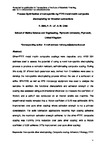Process optimisation of non-cyanide Ag-PTFE metal matrix composite plating for threaded connections
| dc.contributor.author | Sieh, R | |
| dc.contributor.author | Le, HR | |
| dc.contributor.author | Cree, Alistair | |
| dc.date.accessioned | 2015-07-01T20:52:15Z | |
| dc.date.accessioned | 2015-08-10T08:53:45Z | |
| dc.date.available | 2015-07-01T20:52:15Z | |
| dc.date.available | 2015-08-10T08:53:45Z | |
| dc.date.issued | 2015-08-14 | |
| dc.identifier.issn | 0020-2967 | |
| dc.identifier.issn | 1745-9192 | |
| dc.identifier.uri | http://hdl.handle.net/10026.1/3514 | |
| dc.description.abstract |
Silver-PTFE metal matrix composite coatings were deposited onto ANSI 304 stainless steel to assess the potential of using a novel non-cyanide electroplating process to produce a corrosion resistant, self-lubricating composite coating. During this study, 32 different bath parameter sets, derived from 5 variables were used to develop the non-cyanide electroplating process without the use of a surfactant or strike. SEM/EDS as well as XPS microscopy equipment was used to analyse the samples. In addition, the functional characteristic and adhesion strength of the coating was assessed using a bi-directional tribometer (to measure the coefficient of friction) and a pull-off test conducted on an Instron tensile test machine. The experimental results revealed that a friction coefficient of 0.23 was achievable (62% improvement over pure silver coating) where adhesion strength is not a primary consideration. For solid lubrication applications requiring high coating adhesive strength, the maximum adhesion strength achieved for the silver-PTFE composite coating was 2.5MPa (44% reduction over pure silver coating) with a friction coefficient of 0.32 achieved (47% improvement over pure silver coating). | |
| dc.format.extent | 0020296715Z.000-0020296715Z.000 | |
| dc.language | en | |
| dc.language.iso | en | |
| dc.publisher | Maney Publishing | |
| dc.relation.replaces | http://hdl.handle.net/10026.1/3395 | |
| dc.relation.replaces | 10026.1/3395 | |
| dc.title | Process optimisation of non-cyanide Ag-PTFE metal matrix composite plating for threaded connections | |
| dc.type | journal-article | |
| dc.type | Article | |
| plymouth.publication-status | Accepted | |
| plymouth.journal | Transactions of the Institute of Materials Finishing | |
| dc.identifier.doi | 10.1179/0020296715Z.000000000256 | |
| plymouth.organisational-group | /Plymouth | |
| plymouth.organisational-group | /Plymouth/Faculty of Science and Engineering | |
| plymouth.organisational-group | /Plymouth/REF 2021 Researchers by UoA | |
| plymouth.organisational-group | /Plymouth/REF 2021 Researchers by UoA/UoA12 Engineering | |
| plymouth.organisational-group | /Plymouth/Research Groups | |
| plymouth.organisational-group | /Plymouth/Research Groups/Marine Institute | |
| plymouth.organisational-group | /Plymouth/Users by role | |
| plymouth.organisational-group | /Plymouth/Users by role/Academics | |
| dcterms.dateAccepted | 2015-06-27 | |
| dc.identifier.eissn | 1745-9192 | |
| dc.rights.embargoperiod | Not known | |
| rioxxterms.versionofrecord | 10.1179/0020296715Z.000000000256 | |
| rioxxterms.licenseref.uri | http://www.rioxx.net/licenses/all-rights-reserved | |
| rioxxterms.licenseref.startdate | 2015-08-14 | |
| rioxxterms.type | Journal Article/Review |


